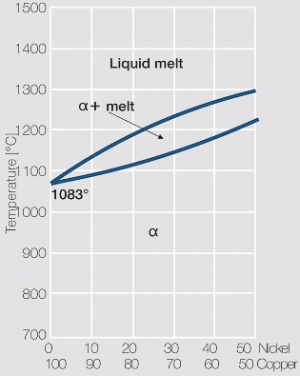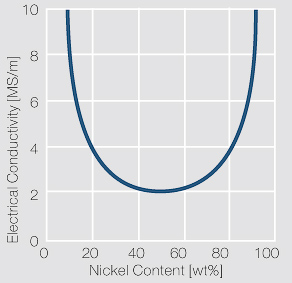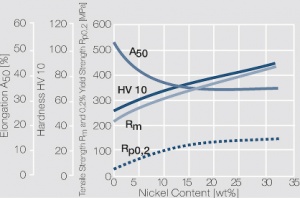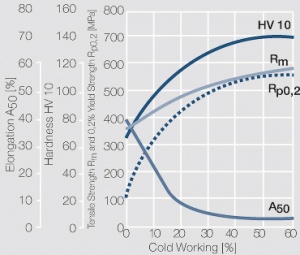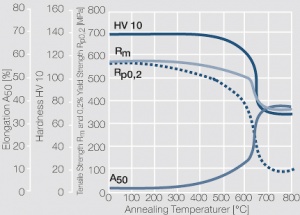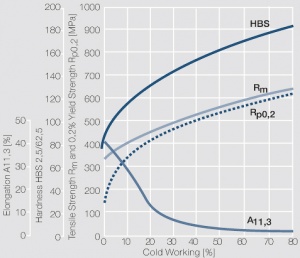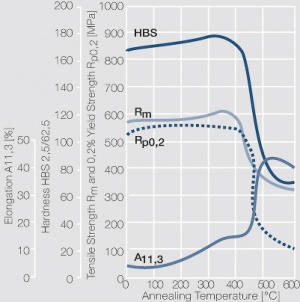Difference between revisions of "Sonstige naturharte Kupfer-Legierungen"
Doduco Admin (talk | contribs) (→Kupfer-Nickel-Zinn-Legierungen) |
Teitscheid (talk | contribs) (temp edit) |
||
| (3 intermediate revisions by 2 users not shown) | |||
| Line 22: | Line 22: | ||
Profile verwendet. | Profile verwendet. | ||
| + | <xr id="fig:Phase_diagram_of_copper-nickel_for_the_range_of_0-50_wt_nickel"/><!--Fig. 5.21:--> Zustandsdiagramm Kupfer-Nickel für den Bereich 0 bis 50 Massen-% Nickel | ||
| + | |||
| + | <xr id="fig:Electrical_conductivity_of_copper-nickel_alloys_as_a_function_of_nickel_content"/><!--Fig. 5.22:--> Elektrische Leitfähigkeit von Kupfer-Nickel-Legierungen in Abhängigkeit vom Nickelgehalt | ||
<div class="multiple-images"> | <div class="multiple-images"> | ||
| Line 42: | Line 45: | ||
{| class="twocolortable" style="text-align: left; font-size: 12px" | {| class="twocolortable" style="text-align: left; font-size: 12px" | ||
|- | |- | ||
| − | !Werkstoff<br />Bezeichnung<br /> | + | !Werkstoff<br />Bezeichnung<br />EN UNS |
!Zusammensetzung<br />[Massen-%] | !Zusammensetzung<br />[Massen-%] | ||
!Dichte<br />[g/cm<sup>3</sup>] | !Dichte<br />[g/cm<sup>3</sup>] | ||
| Line 122: | Line 125: | ||
{| class="twocolortable" style="text-align: left; font-size: 12px" | {| class="twocolortable" style="text-align: left; font-size: 12px" | ||
|- | |- | ||
| − | ! | + | !Material |
| − | ! | + | !Hardness<br />Condition |
| − | ! | + | !Tensile Strength R<sub>m</sub><br />[MPa] |
| − | !0,2% | + | !0,2% Yield Strength<br />R<sub>p02</sub><br />[MPa] |
| − | ! | + | !Elongation<br />A<sub>50</sub><br />[%] |
| − | ! | + | !Vickers<br />Hardness<br />HV |
| − | ! | + | !Bend Radius<sup>1)</sup><br />perpendicular to<br />rolling direction |
| − | ! | + | !Bend Radius<sup>1)</sup><br />parallel to<br />rolling direction |
| − | ! | + | !Spring Bending<br />Limit σ<sub>FB</sub><br />[MPa] |
| − | ! | + | !Spring Fatigue<br />Limit σ<sub>BW</sub><br />[MPa] |
|- | |- | ||
|CuNi25 | |CuNi25 | ||
| Line 178: | Line 181: | ||
|} | |} | ||
</figtable> | </figtable> | ||
| − | <sup>1)</sup> t: | + | <sup>1)</sup> t: Strip thickness max. 0.5 mm |
| + | |||
| + | <xr id="fig:Strain hardening of copper-nickel alloys as a function of nickel content"/><!--Fig. 5.23:--> Strain hardening of copper-nickel alloys as a function of nickel content | ||
| + | |||
| + | <xr id="fig:Strain hardening of CuNi25 by cold working"/><!--Fig. 5.24:--> Strain hardening of CuNi25 by cold working | ||
| + | |||
| + | <xr id="fig:Softening of CuNi25 after 1 hr annealing after 50% cold working"/><!--Fig. 5.25:--> Softening of CuNi25 after 1 hr annealing after 50% cold working | ||
| + | |||
| + | <xr id="fig:Strain hardening of CuNi9Sn2 by cold working (Wieland)"/><!--Fig. 5.26:--> Strain hardening of CuNi9Sn2 by cold working (Wieland) | ||
| + | <xr id="fig:Softening of CuNi9Sn2 after 1 hr annealing after 60% cold working (Wieland)"/><!--Fig. 5.27:--> Softening of CuNi9Sn2 after 1 hr annealing after 60% cold working (Wieland) | ||
<div id="figures6" class="multiple-images"> | <div id="figures6" class="multiple-images"> | ||
<figure id="fig:Strain hardening of copper-nickel alloys as a function of nickel content"> | <figure id="fig:Strain hardening of copper-nickel alloys as a function of nickel content"> | ||
| − | [[File:Strain hardening of copper nickel alloys as function.jpg|left|thumb|<caption> | + | [[File:Strain hardening of copper nickel alloys as function.jpg|left|thumb|<caption>Strain hardening of copper-nickel alloys as a function of nickel content]] |
</figure> | </figure> | ||
<figure id="fig:Strain hardening of CuNi25 by cold working"> | <figure id="fig:Strain hardening of CuNi25 by cold working"> | ||
| − | [[File:Strain hardening of CuNi25 by cold working.jpg|left|thumb|<caption> | + | [[File:Strain hardening of CuNi25 by cold working.jpg|left|thumb|<caption>Strain hardening of CuNi25 by cold working</caption>]] |
</figure> | </figure> | ||
<figure id="fig:Softening of CuNi25 after 1 hr annealing after 50% cold working"> | <figure id="fig:Softening of CuNi25 after 1 hr annealing after 50% cold working"> | ||
| − | [[File:Softening of CuNi25 after annealing after 50.jpg|left|thumb|<caption> | + | [[File:Softening of CuNi25 after annealing after 50.jpg|left|thumb|<caption>Softening of CuNi25 after 1 hr annealing after 50% cold working</caption>]] |
</figure> | </figure> | ||
<figure id="fig:Strain hardening of CuNi9Sn2 by cold working (Wieland)"> | <figure id="fig:Strain hardening of CuNi9Sn2 by cold working (Wieland)"> | ||
| − | [[File:Strain hardening of CuNi9Sn2 by cold working.jpg|left|thumb|<caption> | + | [[File:Strain hardening of CuNi9Sn2 by cold working.jpg|left|thumb|<caption>Strain hardening of CuNi9Sn2 by cold working (Wieland)</caption>]] |
</figure> | </figure> | ||
<figure id="fig:Softening of CuNi9Sn2 after 1 hr annealing after 60% cold working (Wieland)"> | <figure id="fig:Softening of CuNi9Sn2 after 1 hr annealing after 60% cold working (Wieland)"> | ||
| − | [[File:Softening of CuNi9Sn2 after annealing Wieland.jpg|left|thumb|<caption> | + | [[File:Softening of CuNi9Sn2 after annealing Wieland.jpg|left|thumb|<caption>Softening of CuNi9Sn2 after 1 hr annealing after 60% cold working (Wieland)</caption>]] |
</figure> | </figure> | ||
</div> | </div> | ||
Revision as of 23:40, 19 September 2014
Kupfer-Nickel-Legierungen
Kupfer und Nickel sind im festen und flüssigen Zustand lückenlos mischbar (Figure 1). Wegen ihrer sehr niedrigen elektrischen Leitfähigkeit werden Kupfer-Nickel-Legierungen vor allem als Widerstandslegierungen verwendet (Figure 2). Verfestigungs- und Erweichungsverhalten von Kupfer-Nickel-Legierungen sowie von CuNi9Sn2 sind in den Bildern (Figs. 3 – 7) aufgeführt. Kupfer-Nickel-Legierungen zeichnen sich weiter durch eine hohe Korrosionsbeständigkeit, gute Schweißbarkeit und günstiges Plattierverhalten aus. Daher werden sie mit und ohne Eisen- und Manganzusatz in großem Umfang als gut schweißbare Unterlage für Aufschweißkontakte sowie plattierte Profile verwendet (Table 1 und Table 2).
Kupfer-Nickel-Zinn-Legierungen
Kupfer-Nickel-Mehrstofflegierungen mit 9 Massen-% Ni und 2 Massen-% Sn werden aufgrund ihrer günstigen mechanischen Eigenschaften, ihres herausragenden Relaxationsverhaltens und ihrer hohen Anlaufbeständigkeit als Federwerkstoff vor allem in Steckverbindern eingesetzt. Hervorzuheben ist weiter die hohe Temperaturbeständigkeit und gute Weichlötbarkeit auch nach längerer Lagerung. Sie werden vielfach auch als Basiswerkstoffe für plattierte Profile verwendet.
Figure 1 Zustandsdiagramm Kupfer-Nickel für den Bereich 0 bis 50 Massen-% Nickel
Figure 2 Elektrische Leitfähigkeit von Kupfer-Nickel-Legierungen in Abhängigkeit vom Nickelgehalt
| Werkstoff Bezeichnung EN UNS |
Zusammensetzung [Massen-%] |
Dichte [g/cm3] |
Elektr. Leitfähigkeit | Elektr. Widerstand [μΩ·cm] |
Wärmeleitfähigkeit [W/(m·K)] |
Lin. Ausdehnungskoeff. [10-6/K] |
E-Modul [GPa] |
Erweichungstemperatur (ca. 10% Festigkeitsabfall) [°C] |
Schmelzbereich [°C] | |
|---|---|---|---|---|---|---|---|---|---|---|
| [MS/m] | [% IACS] | |||||||||
| CuNi25 CW350H C71300 |
Ni 24 - 26 Mn 0.5 Zn 0.5 Fe 0.3 Cu Rest |
8.94 | 3.0 | 5.2 | 33.3 | 29 | 15.5 | 147 | ca. 500 | 1150 - 1210 |
| CuNi9Sn2 CW351H C72500 |
Ni 8.5 - 10.5 Sn 1.8 - 2.8 Mn 0.3 Fe 0.3 Cu Rest |
8.89 | 6.4 | 11 | 15.6 | 50 | 16.5 | 140 | ca. 480 | 1060 - 1120 |
| CuNi10Fe1Mn CW352H C70600 |
Ni 9.0 - 11.0 Fe 1.0 - 2.0 Mn 0.5 - 1.0 Zn 0.5 Cu Rest |
8.92 | 5.6 | 9 | 17.9 | 50 | 16.5 | 134 | ||
| CuNi30Mn1Fe CW354H C71500 |
Ni 30 - 32 Mn 0.5 - 1.5 Fe 0.4 - 1.0 Zn 0.5 Cu Rest |
8.93 | 2.6 | 4 | 38.5 | 29 | 15.5 | 152 | 1180 - 1240 | |
| Material | Hardness Condition |
Tensile Strength Rm [MPa] |
0,2% Yield Strength Rp02 [MPa] |
Elongation A50 [%] |
Vickers Hardness HV |
Bend Radius1) perpendicular to rolling direction |
Bend Radius1) parallel to rolling direction |
Spring Bending Limit σFB [MPa] |
Spring Fatigue Limit σBW [MPa] |
|---|---|---|---|---|---|---|---|---|---|
| CuNi25 | R 290 | ≥ 290 | 100 | 30 | 70 - 100 | ||||
| CuNi9Sn2 | R 340 R 380 R 450 R 500 R 560 |
340 - 410 380 - 470 450 - 530 500 - 580 560 - 650 |
≤ 250 ≥ 200 ≥ 370 ≥ 450 ≥ 520 |
20 8 4 2 |
75 - 110 100 - 150 140 - 170 160 - 190 180 - 210 |
0 x t 0 x t 0 x t 1 x t |
0 x t 0 x t 0 x t 2 x t |
520 | 250 |
| CuNi10Fe1Mn | R 300 R 320 |
≥ 300 ≥ 320 |
≤ 100 ≤ 200 |
20 | 70 - 120 ≥ 100 |
||||
| CuNi30Mn1Fe | R 350 R 410 |
350 - 420 ≥ 410 |
≤ 120 ≤ 300 |
35 | 80 - 120 ≥ 110 |
1) t: Strip thickness max. 0.5 mm
Figure 3 Strain hardening of copper-nickel alloys as a function of nickel content
Figure 4 Strain hardening of CuNi25 by cold working
Figure 5 Softening of CuNi25 after 1 hr annealing after 50% cold working
Figure 6 Strain hardening of CuNi9Sn2 by cold working (Wieland)
Figure 7 Softening of CuNi9Sn2 after 1 hr annealing after 60% cold working (Wieland)
